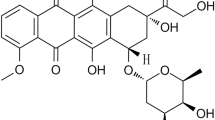We studied the effect of inhibition of mitochondrial voltage-dependent anion channels with DIDS on radiosensitivity and mitochondrial status of K562 leukemic cells. The number of apoptotic and necrotic cells, mitochondrial transmembrane potential, and mitochondrial mass were evaluated after irradiation of cells in doses of 4 and 12 Gy in the presence and absence of the inhibitor. Inhibition of mitochondrial voltage-dependent anion channels increased radiosensitivity of K562 cells by 50-70% and decreased both mitochondrial transmembrane potential and mitochondrial mass. Inhibitors of voltage-dependent anion channels are promising agents capable of improving the effectiveness of cancer radiotherapy.
Similar content being viewed by others
References
A. Cossarizza, G. Kalashnikova, E. Grassilli, F. Chiappelli, S. Salvioli, M. Capri, D. Barbieri, L. Troiano, D. Monti, and C. Franceschi, Mitochondrial modifications during rat thymocyte apoptosis: a study at the single cell level. Exp. Cell Res., 214, No. 1, 323–330 (1994).
Z. Gan, S. H. Audi, R. D. Bongard, K. M. Gauthier, and M. P. Merker, Quantifying mitochondrial and plasma membrane potentials in intact pulmonary arterial endothelial cells based on extracellular disposition of rhodamine dyes. Am. J. Physiol. Lung Cell. Mol. Physiol., 300, No. 5, L762-L772 (2011).
D. Han, F. Antunes, R. Canali, D. Rettori, and E. Cadenas, Voltage-dependent anion channels control the release of the superoxide anion from mitochondria to cytosol. J. Biol. Chem., 278, No. 8, 5557–5563 (2003).
J. A. Hannay, J. Liu, Q. S. Zhu, S. V. Bolshakov, L. Li, P. W. Pisters, A. J. Lazar, D. Yu, R. E. Pollock, and D. Lev, Rad51 overexpression contributes to chemoresistance in human soft tissue sarcoma cells: a role for p53/activator protein 2 transcriptional regulation. Mol. Cancer. Ther., 6, No. 5, 1650–1660 (2007).
T. Himi, Y. Ishizaki, and S. I. Murota, 4,4’-Diisothiocyano- 2,2’-stilbenedisulfonate protects cultured cerebellar granule neurons from death. Life Sci., 70, No. 11, 1235–1249 (2002).
M. Huizing, W. Ruitenbeek, L. P. van den Heuvel, V. Dolce, V. Iacobazzi, J. A. Smeitink, F. Palmieri, and J. M. Trijbels, Human mitochondrial transmembrane metabolite carriers: tissue distribution and its implication for mitochondrial disorders, J. Bioenerg. Biomembr., 30, No. 3, 277–284 (1998).
T. Ishida, Y. Takizawa, T. Kainuma, J. Inoue, T. Mikawa, T. Shibata, H. Suzuki, S. Tashiro, and H. Kurumizaka, DIDS, a chemical compound that inhibits RAD51-mediated homologous pairing and strand exchange. Nucleic Acids Res., 37, No. 10, 3367–3376 (2009).
K. R. Lamont, M. G. Hasham, N. M. Donghia, J. Branca, M. Chavaree, B. Chase, A. Breggia, J. Hedlund, I. Emery, F. Cavallo, M. Jasin, J. Rüter, and K. D. Mills, Attenuating homologous recombination stimulates an AID-induced antileukemic effect. J. Exp. Med., 210, No. 5, 1021–1033 (2013).
K. Mizoguchi, H. Maeta, A. Yamamoto, M. Oe, and H. Kosaka, Amelioration of myocardial global ischemia/reperfusion injury with volume-regulatory chloride channel inhibitors in vivo. Transplantation, 73, No. 8, 1185–1193 (2002).
E. Nozik-Grayck, C. A. Piantadosi, J. van Adelsberg, S. L. Alper, and Y. Huang, Protection of perfused lung from oxidant injury by inhibitors of anion exchange. Am. J. Physiol., 273, No. 2, Pt 1, L296-L304 (1997).
Y. Saenko, A. Cieslar-Pobuda, M. Skonieczna, and J. Rzeszowska- Wolny, Changes of reactive oxygen and nitrogen species and mitochondrial functioning in human K562 and HL60 cells exposed to ionizing radiation. Radiat. Res., 180, No. 4, 360–366 (2013).
J. M. Sage, O. S. Gildemeister, and K. L. Knight, Discovery of a novel function for human Rad51: maintenance of the mitochondrial genome. J. Biol. Chem., 285, No. 25, 18,984-18,990 (2010).
V. Shoshan-Barmatz, D. Mizrachi, and N. Keinan, Oligomerization of the mitochondrial protein VDAC1: from structure to function and cancer therapy. Prog. Mol. Biol. Transl. Sci., 117, 303–334 (2013).
M. van Engeland, L. J. Nieland, F. C. Ramaekers, B. Schutte, and C. P. Reutelingsperger, Annexin V-affinity assay: a review on an apoptosis detection system based on phosphatidylserine exposure. Cytometry, 31, No. 1, 1–9 (1998).
Author information
Authors and Affiliations
Corresponding author
Additional information
Translated from Byulleten’ Eksperimental’noi Biologii i Meditsiny, Vol. 161, No. 1, pp. 119–123, January, 2016
Rights and permissions
About this article
Cite this article
Saenko, Y.V., Mastilenko, A.V., Glushchenko, E.S. et al. Inhibition of Mitochondrial Voltage-Dependent Anion Channels Increases Radiosensitivity of K562 Leukemic Cells. Bull Exp Biol Med 161, 104–107 (2016). https://doi.org/10.1007/s10517-016-3356-8
Received:
Published:
Issue Date:
DOI: https://doi.org/10.1007/s10517-016-3356-8




